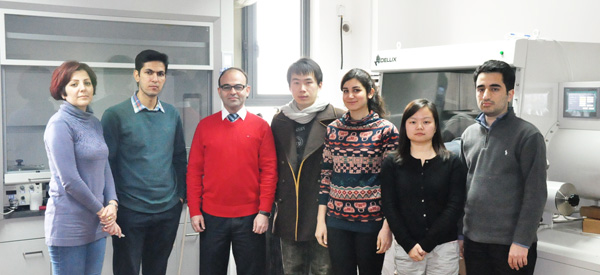JI Associate Professor, Morteza Eslamian, has won the title of Oriental Scholar, namely Distinguished Professor in Shanghai Universities, awarded by the Shanghai Municipal Education Commission, along with six other SJTU Professors in 2014. The award provides research fund for his proposal entitled “Fabrication of Polymer and Perovskite Photovoltaic Solar Cells by Spray Coating.”
Prof. Eslamian is the Director of the Spray-On PV Solar Cell Laboratory at the Joint Institute. The research group currently consists of two Postdoctoral Research Fellows, two Ph.D. students, two master students, and one undergraduate research assistant, working on emerging thin film solar cells.
 Prof. Eslamian’s research team: (from left) Dr. Fatemeh Zabihi, Mr. Mehran Habibi, Dr. Morteza Eslamian (Lab Director), Mr. Qin Wang, Miss Firuze Soltani, Dr. Yu Xie, Mr. Reza Ahmadian
Prof. Eslamian’s research team: (from left) Dr. Fatemeh Zabihi, Mr. Mehran Habibi, Dr. Morteza Eslamian (Lab Director), Mr. Qin Wang, Miss Firuze Soltani, Dr. Yu Xie, Mr. Reza Ahmadian
Prof. Eslamian’s research focuses on micro and nano energy conversion and transport. In his proposal on fabrication of solar cells by spray coating, he argues that because most of the emerging thin film solar cells are solution processed (solar cell materials are dissolved in a solvent and deposited in a substrate in ambient conditions using low-cost and vacuum-free methods, such as spin or spray coating), there is no need for expensive processes for their fabrication. Perovskite solar cell is the newest member of emerging solution-processed thin film solar cells. Within a few years its efficiency has increased to about 20%. Polymer solar cell is another solution processed solar cell, which is rather mature and has been under investigations for a decade. The potential for large scale application of the perovskite and polymer thin film solar cells necessitates the development of cost-effective fabrication techniques and high photon to electron conversion efficiency solar cell materials. Most solution-processed solar cells are fabricated by spin-coating, which is a lab-scale method. Prof. Eslamian’s team uses spray coating, which is much faster, and can produce large area cells. Innovative ideas, such as imposing ultrasonic vibration on the substrate (recently developed in our lab) and doping the solar cell materials and layers with conductive agents such as graphene and carbon nanotube, have been employed to improve the device performance.
Background Information
Prof. Eslamian received his BS degree from Sharif University of Technology and Shiraz University in 1998, MS degree from Sharif University of Technology in 2000, and Ph.D. from the University of Toronto in 2006. He has worked as a Postdoctoral Fellow and Research Associate at Ryerson University, University of Toronto, and Swiss Federal Institute of Technology (ETH) Zurich. Prior to joining the Joint Institute, he worked as an Assistant Professor at Texas A&M University from 2011 to 2013. He has authored and co-authored more than 60 Journal papers and book chapters in the areas of thermal-fluid sciences, nanoparticle research, nanofluids and nanotechnology, thin films and thin film solar cells.





